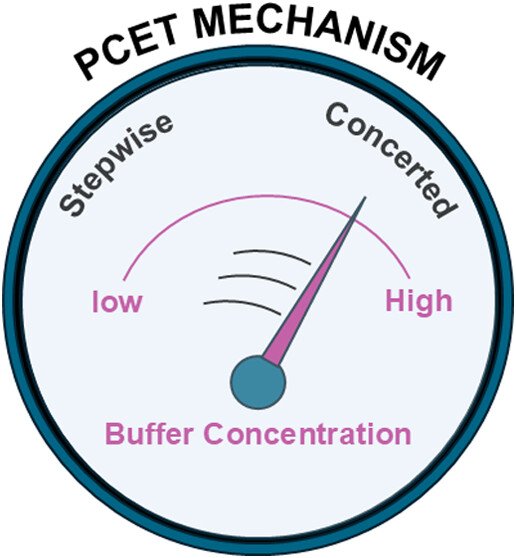Direct Evidence for Buffer-Enhanced Proton-Coupled Electron Transfer Generation of a High-Valent Metal-Oxo Complex
The oxidation of metal-aquo and -hydroxo complexes to generate the high-valent metal-oxo species used in oxidative catalysis is often kinetically slow due to sluggish proton transfer between ligated −H₂O/–OH in the proton-coupled electron transfer (PCET) chemistry. In this research, a ruthenium water oxidation catalyst anchored to a conductive tin-doped indium oxide (ITO) thin film, abbreviated ITO|Ru(II)–OH₂, was characterized by spectroscopic and electrochemical methods in acetate or phosphate buffers. The deprotonated intermediate, Ru(II)–OH, was observed spectroscopically in the PCET half-reaction ITO(e⁻)|RuIII–OH + H⁺ → ITO|Ru(II)–OH₂ indicating an underlying stepwise ET-PT mechanism. In contrast, at elevated buffer concentrations, this intermediate was absent, and a 2–4 order of magnitude increase in the proton transfer rate constant was observed. Kinetic data for this PCET reaction measured as a function of the driving force provided the reorganization energy λ = 1.05 eV and was assigned to a concerted electron–proton transfer (EPT) mechanism. In addition, the standard heterogeneous rate constants for two PCET equilibria, Ru(III)–OH + H⁺ + e⁻ ⇌ Ru(II)–OH₂ and Ru(IV)=O + H⁺ + e⁻ ⇌ Ru(III)–OH were enhanced by these same buffers. Collectively, the data show that the added buffers can enhance the kinetics and thermodynamics for PCET reactions relevant to oxidative catalysis.
Kessinger, M.; Grandi, S.; Whittemore, T.; Danilov, E.; Castellano, F.; Caramori, S.; Meyer, G. Direct Evidence for Buffer-Enhanced Proton-Coupled Electron Transfer Generation of a High Valent Metal-oxo Complex, Inorg. Chem., 2025, 64(22), 10850-10861. https://doi.org/10.1021/acs.inorgchem.5c00650

